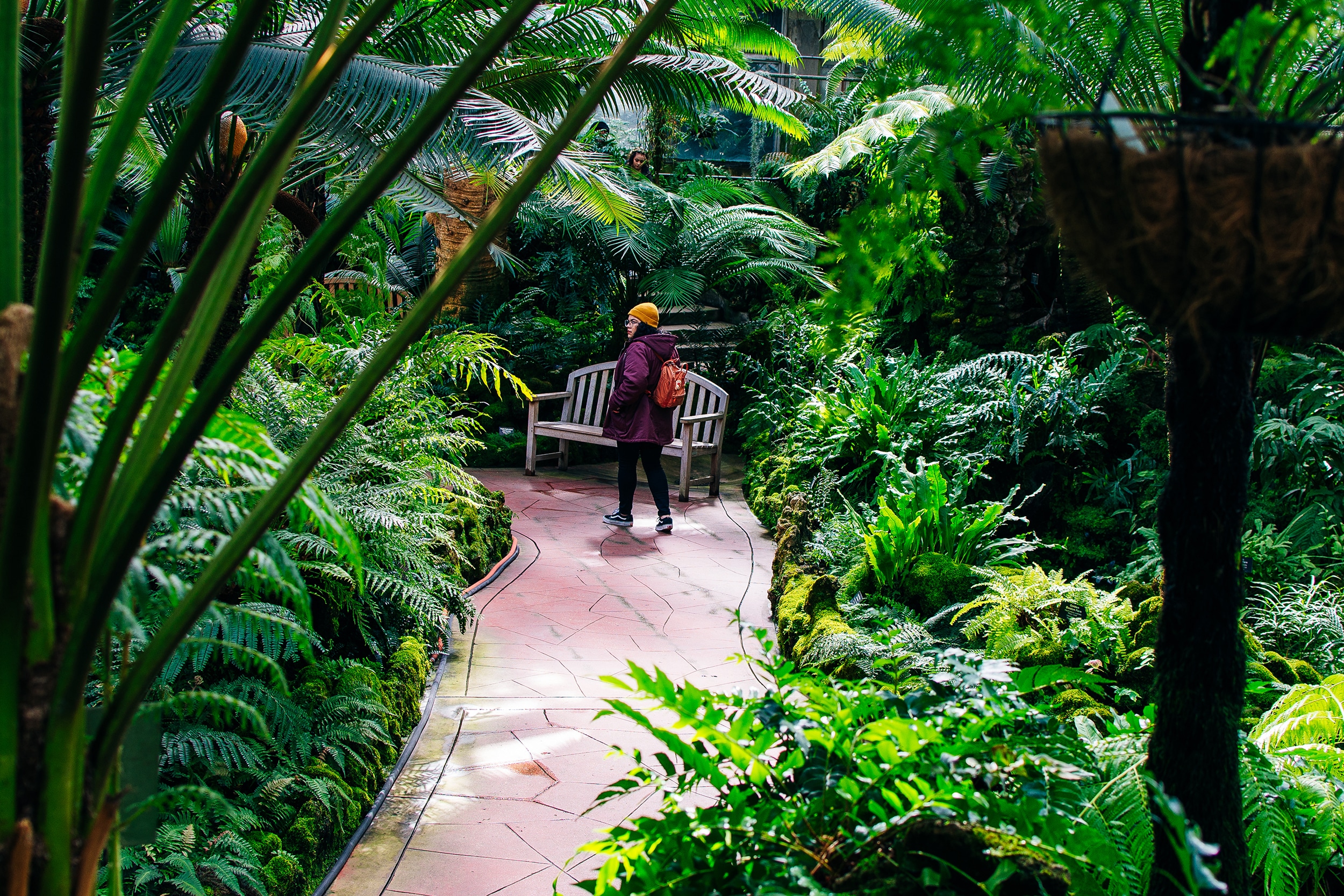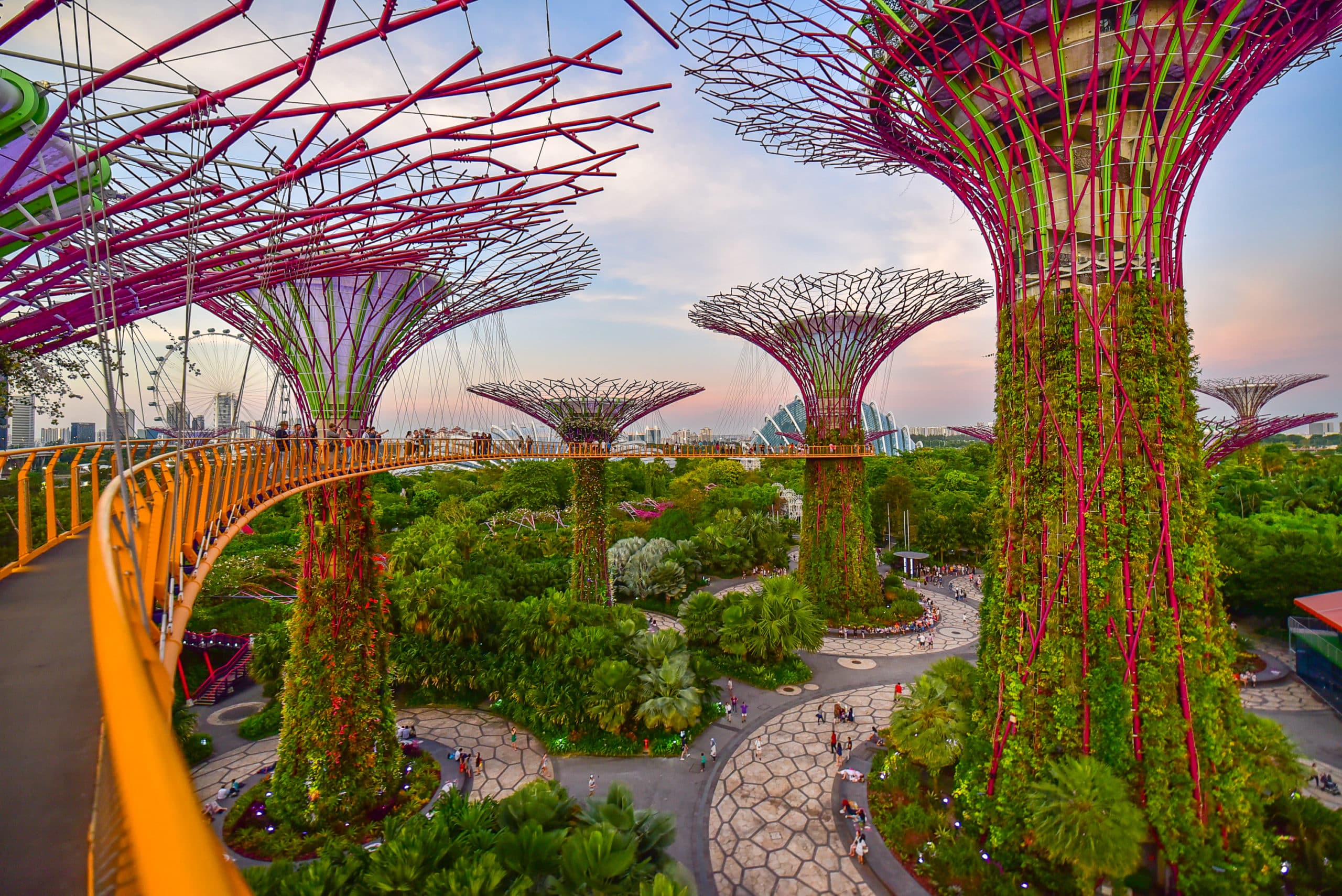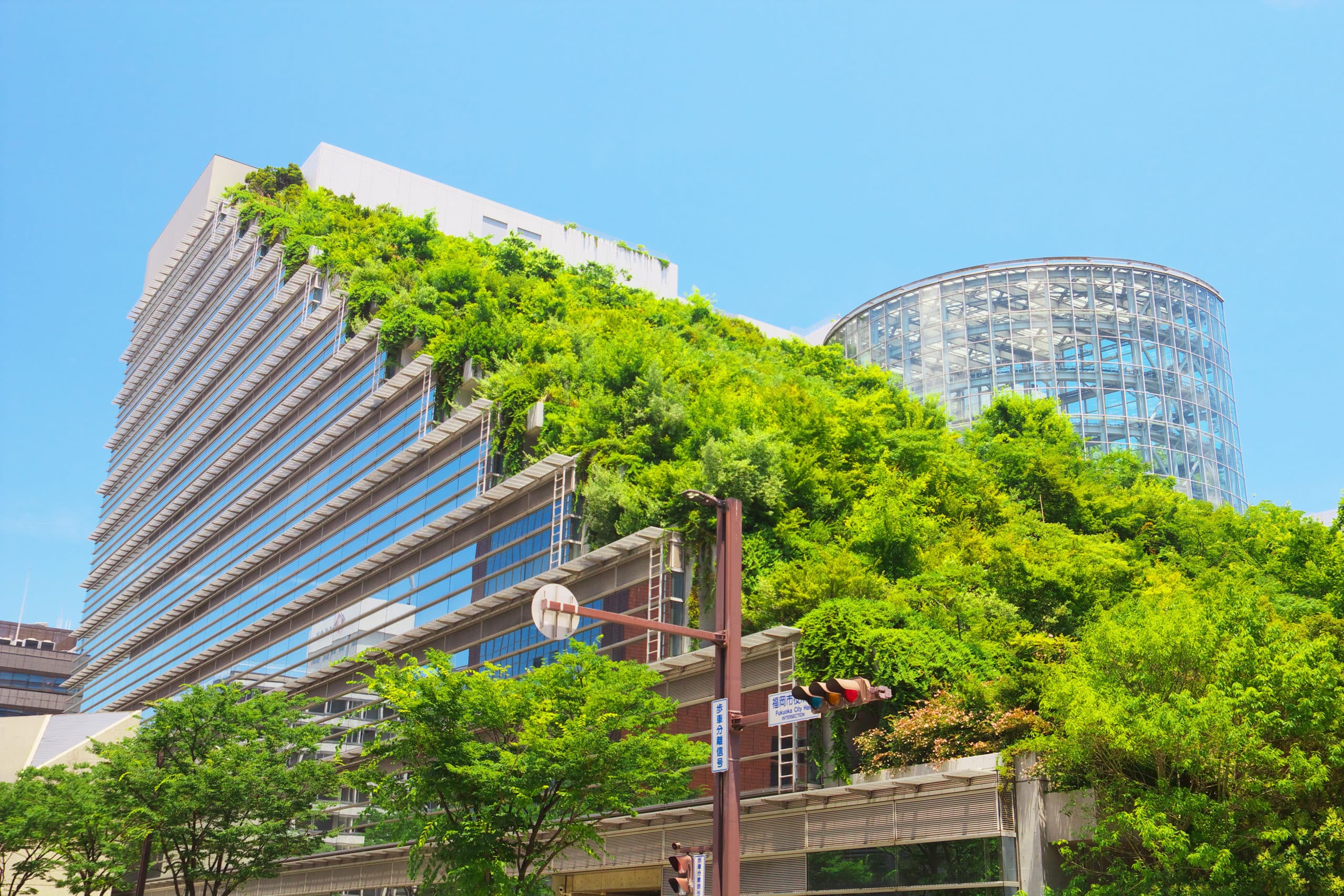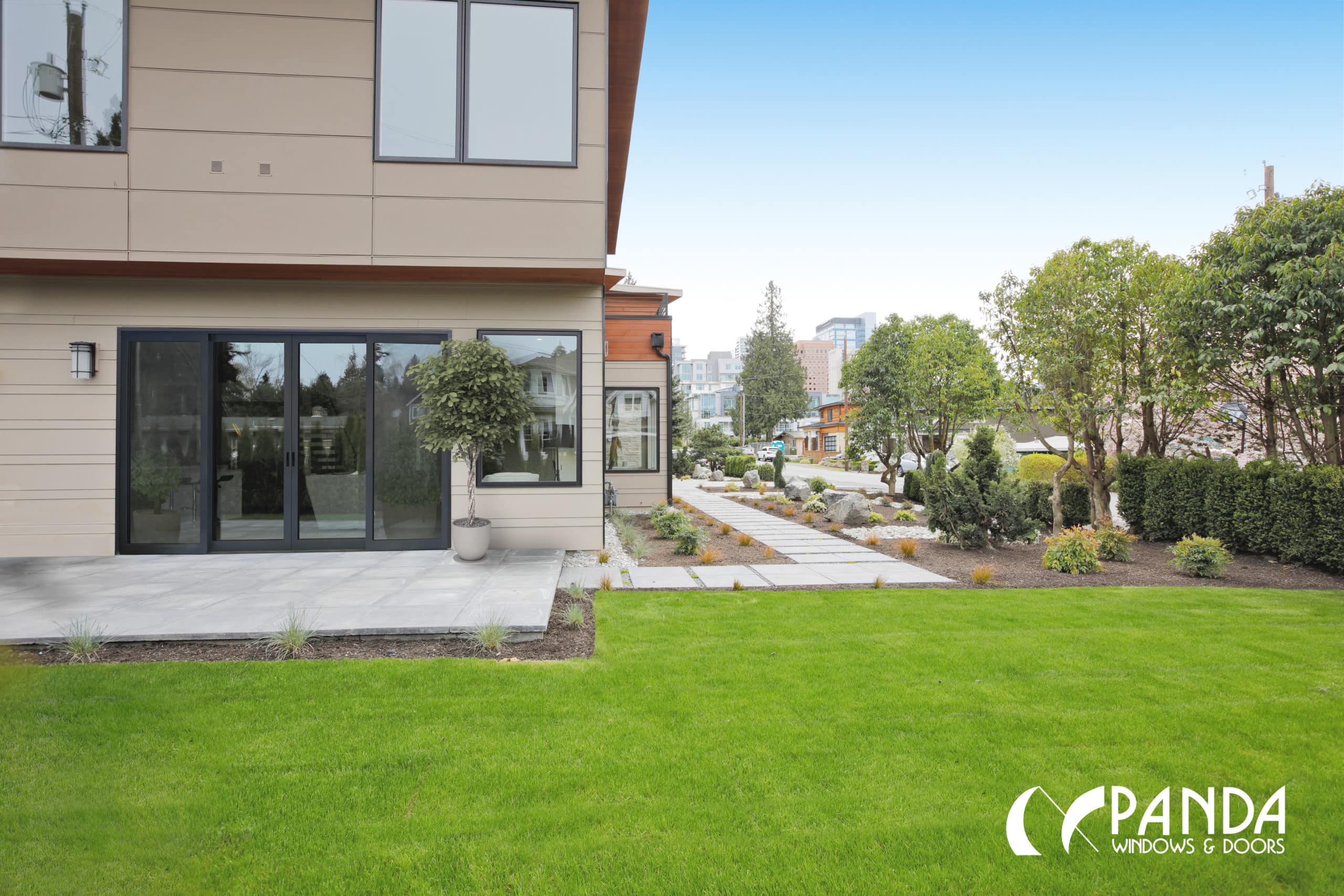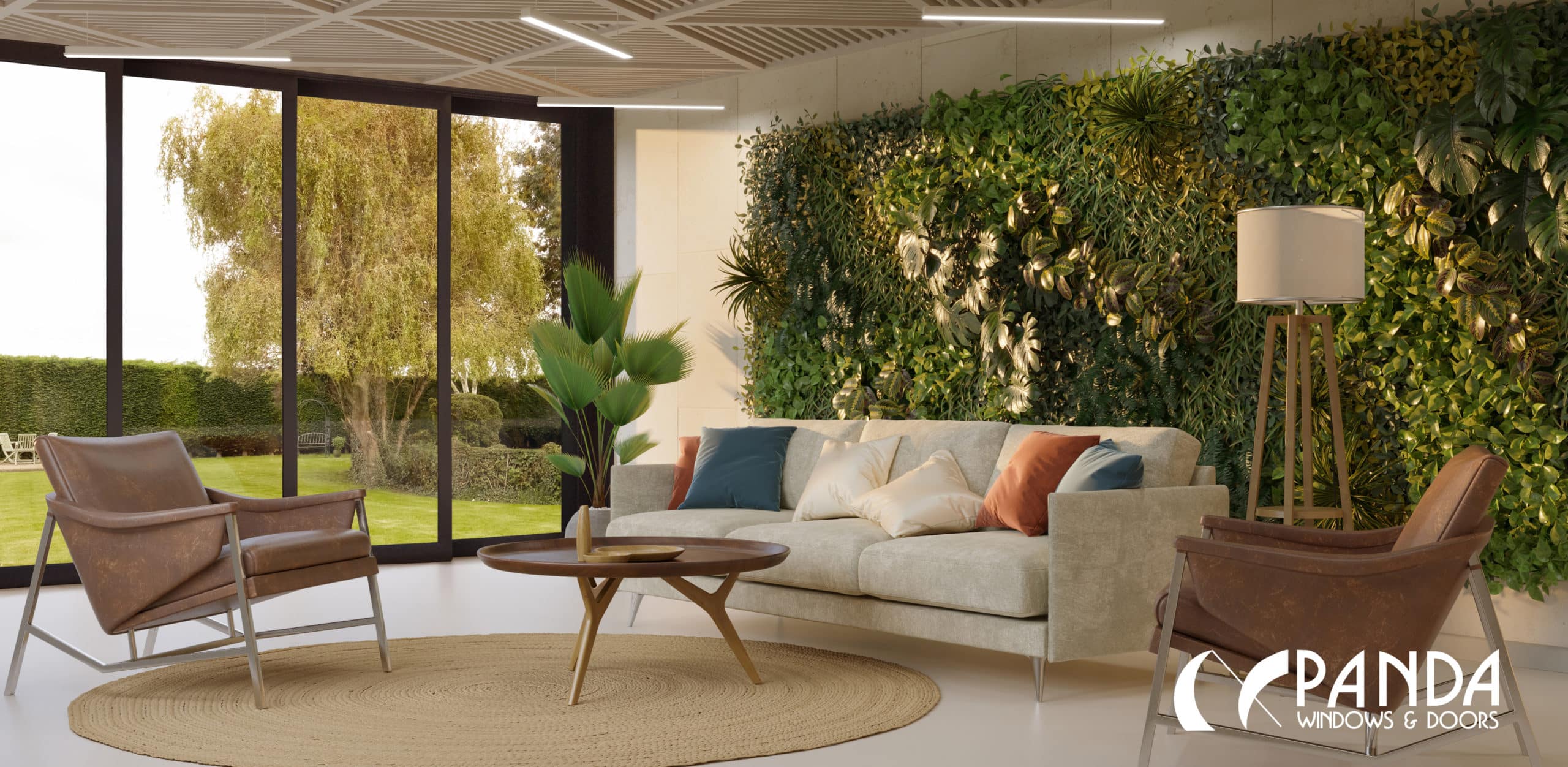Going Backward to Move Forward: Perks of Biophilic Design
August 1, 2022
Industrialization and design have given us the unearned notion that humans can transcend their natural and genetic heritage. We’ve grown into creatures that value peace and quiet, lavishly designed spaces, stability in our infrastructure, cleanliness and minimalism. But what we often fail to acknowledge is that we were created from and evolved side by side in a world that is messy, organic, sensorially chaotic and not made by us. We forget that we do not own nature, nature does not need us—we need it. Our bodies crave its nutrients and its oxygen. We desire it by instinct.
The Biophilia Hypothesis
Coined by social psychologist, Eric Fromm, the term Biophilia is the idea that even as humans evolve, we maintain an innate desire to be connected to and at one with nature. The term was popularized by biologist, Edward Wilson, who expounded upon this Aristotelian concept of a, “love of life”—Bio, meaning life, and philia, meaning love of. Like taking a deep breath as instinct or being enraptured by the vastness of a sunrise over a deep valley. Nature calls to us. It’s in our DNA, our spirituality and day-to-day rituals and practices. This is what the Biophilic Hypothesis proposes.
As proof of this concept’s existence, we can look to its antonym: bio-phobia, or a fear of nature and life. Humans have evolved to have phobias of spiders, snakes, darkness, etc. because at some point in their evolution, it was quite common to have a direct experience with these predators that were a threat to their life and existence. There were no remedies, anecdotes or street lights, so they developed an internal defensiveness to such things. In opposition to this experience, there was biophilia, which you could say manifested itself into such experiences as an attraction to a crackling fire, fascination with waterfalls and rolling waves, or even open valleys. Additionally animal companionship should be included in this biophilia hypothesis. These creatures went from being our protectors, transporters and companions in nature, to being our dogs, cats, and other pets.
An Industrial Nightmare
Researchers have found that the presence of plants and natural elements can increase our mental health, stamina and boost our moods. However, in a modern society that has been so industrialized, we have fewer chances of being connected to the elements, due to our large cities being built on top of these natural landscapes. This surge in the destruction of nature over the course of the last several centuries can be traced back to the Industrial Revolution.
After the Black Plague, the world’s population finally began to recover around the 1700’s. By the 1800s the world’s population grew to around 1 billion, and steadily increased from there. With this boom in population, the need for cities to grow and develop their infrastructure led to the need for a more efficient energy source in construction; thus, the increased popularity of coal as a primary means of production fuel.
With this production efficient material on the rise, not much thought was given to the lasting environmental impact it would have. The near-sighted goal of having an industry boom was the only motive: how can we build as much as possible, as quick as possible. This caused air pollution from the smoke of burning fossil fuels, and factories built near bodies of water would contaminate them with toxins, making it hazardous to consume or utilize in production. Waste would also be disposed of in landfills, disposing of toxic chemicals like lead and other metals and contaminating the soil. Additionally, to make room for the burgeoning cities, habitats would be destroyed. Deforestation and other exploitative process would be utilized to create paved roads and build more homes.
Before the Industrial Revolution, most people lived an Agrarian lifestyle. This means many families resources of food, home construction and transportation were based on their own capabilities or farming, maintaining crops, and building lasting shelters from natural materials. If not by their own means of production, then they had to have lived in a community with access to trade smiths who could produce all of this and were willing to put in the labor to create home and infrastructure conducive of life. Then, the industrial revolution set the precedent for future developments to increase production without environmental consideration and fostered a culture of disregard for nature. This is how we got metropolises like New York, Chicago and Los Angeles.
It shouldn’t have to be such a black and white choice between farm life and concrete jungles. So, how do we compromise? How can we keep building upon and improving our cities, while paying respect to the human nature connection we so desperately crave? One answer, is Biophilic Design.
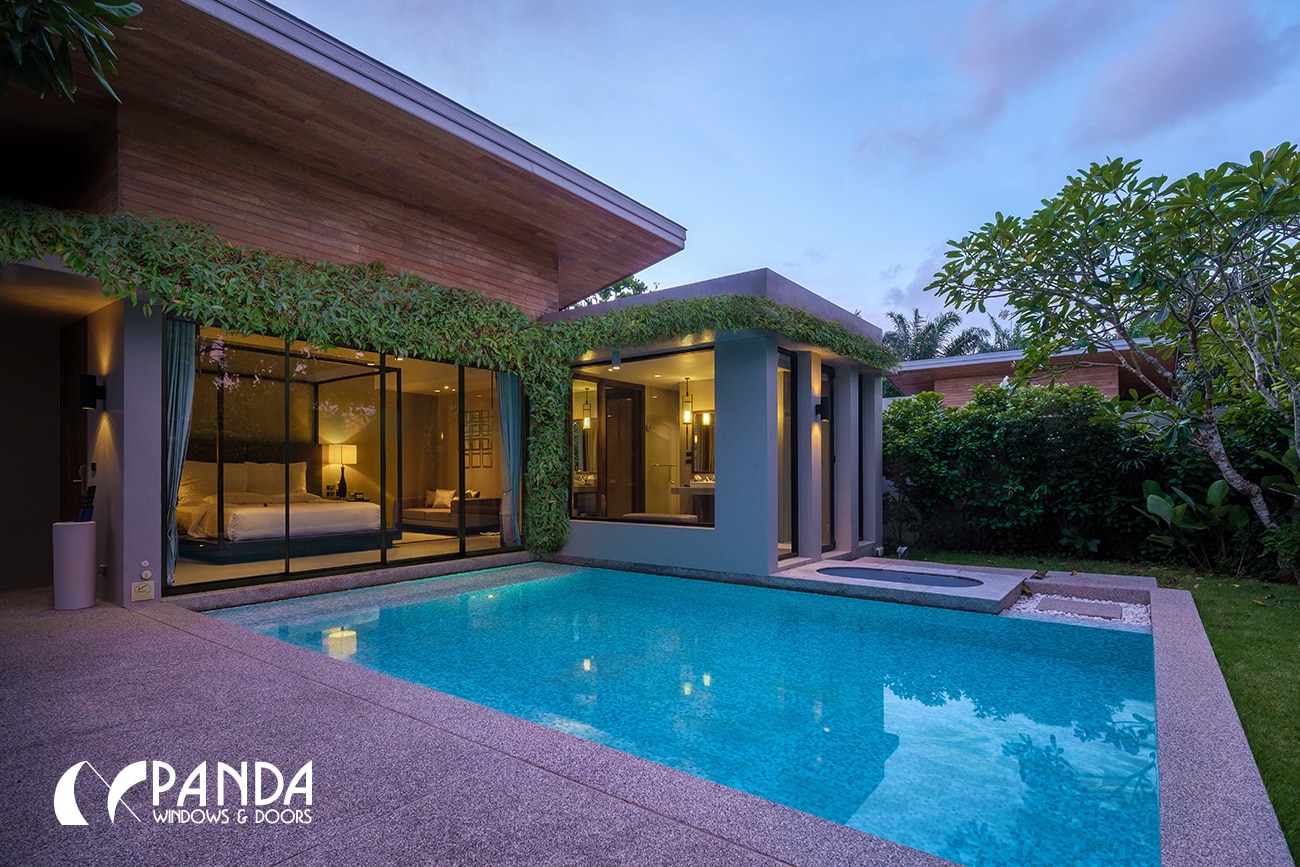
Biophilic Design
In the book Biophilic Design: The Theory, Science and Practice of Bringing Buildings to Life by Kellert, Heerwagen and Mador, Biophilic Design—branched off of the idea of Biophilia—is “an innovative approach that emphasizes the necessity of maintaining, enhancing, and restoring the beneficial experience of nature in the built environment.” Essentially, it is a way of giving the natural environment a means of reclamation in our modern built environments. There are cities in the world, like Singapore for example, that make the extra effort to promote citywide Biophilic Design. These green cities start with a curiosity of how the built world affects the natural world, then understanding how we infiltrate these concrete jungles to bring back the life that was once consumed to erect them.
Elements of Biophilic Design
Biophilic spaces reduce stress, promote mental wellbeing, creativity and feed the biological need of humans to be intermingling with nature. But how is it done? Well, there are three main methods utilized in developing a Biophilic Space: Nature in the space, Nature of the space, Natural Analogues.
Nature in the Space
One of the most common ways of implementing a Biophilic Design is by having nature in the space or in the design of the space. Some methods of crafting an environment with natural materials include:
- Visual connection of nature in the space through a direct view of nature. This can be created with windows, glass doors or openings.
- Non-visual connection with nature through auditory, haptic olfactory or gustatory stimulus.
- Non-Rhythmic Sensory Stimuli through stochastic and ephemeral connections with nature that may be analyzed statistically but may not be predicted precisely.
- Thermal & Airflow Variability through subtle changes in air temperature, relative humidity, airflow across the skin and surface temperatures that mimic natural environments.
- Presence of Water by utilizing a condition that enhances the experience of a place through seeing, hearing or touching water.
- Dynamic & Diffused Light in order to leverage varying intensities of light and shadow that change over time to create conditions that occur in nature.
- Connection with Natural Systems to create an awareness of natural process, especially seasonal and temporal changes characteristic of a healthy ecosystem.
Nature of the Space
What is the space naturally offering you? How can you lean into that or expound upon that? Utilizing the nature of the space in Biophilic Design is an essential step in observing, understanding and maximizing the potential of your space. Some ways a space can be utilized are as follows:
- Prospect: An unimpeded view over a distance, for surveillance and planning
- Refuge: A place for withdrawal from environmental conditions or the main flow of activity, in which the individual is protected from behind and overhead
- Mystery: The promise of more information, achieved through partially obscured views of other sensory devices that entice the individual to travel deeper into the environment
Natural Analogues
Perhaps it’s more sustainable to falsify nature. How can we fabricate the feeling of nature without bringing in physical elements from the outside world? Natural Analogues are natural, organic, non-living architectural elements that evoke the feeling of nature. Below are some methods of creating Natural Analogues:
- Biomorphic forms and patterns: Symbolic references to contoured, patterned, textures or numerical arrangements that persist in nature
- Material connection with nature: Materials and elements from nature that, through minimal processing, reflect the local ecology or geology and create a distinct sense of place
- Complexity & Order: Rich sensory information that adheres to a spiritual hierarchy similar to those encountered in nature
A Lesson from the Past
It may seem the integration of plants and natural materials into architecture is the way of the future, and a modern means of development, but it is actually a way of getting back to how structures have been built throughout history. Plant life in architecture is nowhere near a new concept. It is only in modern architecture that we have been making strides towards a clean and geometric design philosophy. Architecture and nature have actually been intertwined through various prominent sites around the world.
Take for example the Gobeki Tepe in modern day Turkey. The Neolithic structure is crafted of rock formations built directly into the earth. It is unclear the exact purpose of the location, but it is clear the elements were not stripped of their native purpose or appearance in crafting the exhibit
The Aviary in Teotihuacan are a set of Aztec Pyramids near Mexico City built of stone and utilizing the vastness of the landscape to create a city of sorts
The Alhambra in Granada, Spain is a palace that was built for the cities Moorish monarchs. The fortress was built into a thicket of trees and overlooks parts of the city. The greenery is a feature of the architectural design.
Even simpler than these previous grandiose examples are the garden cottages in Medieval Germany. These small huts would have vines and foliage growing into the brick and becoming a feature on the home.
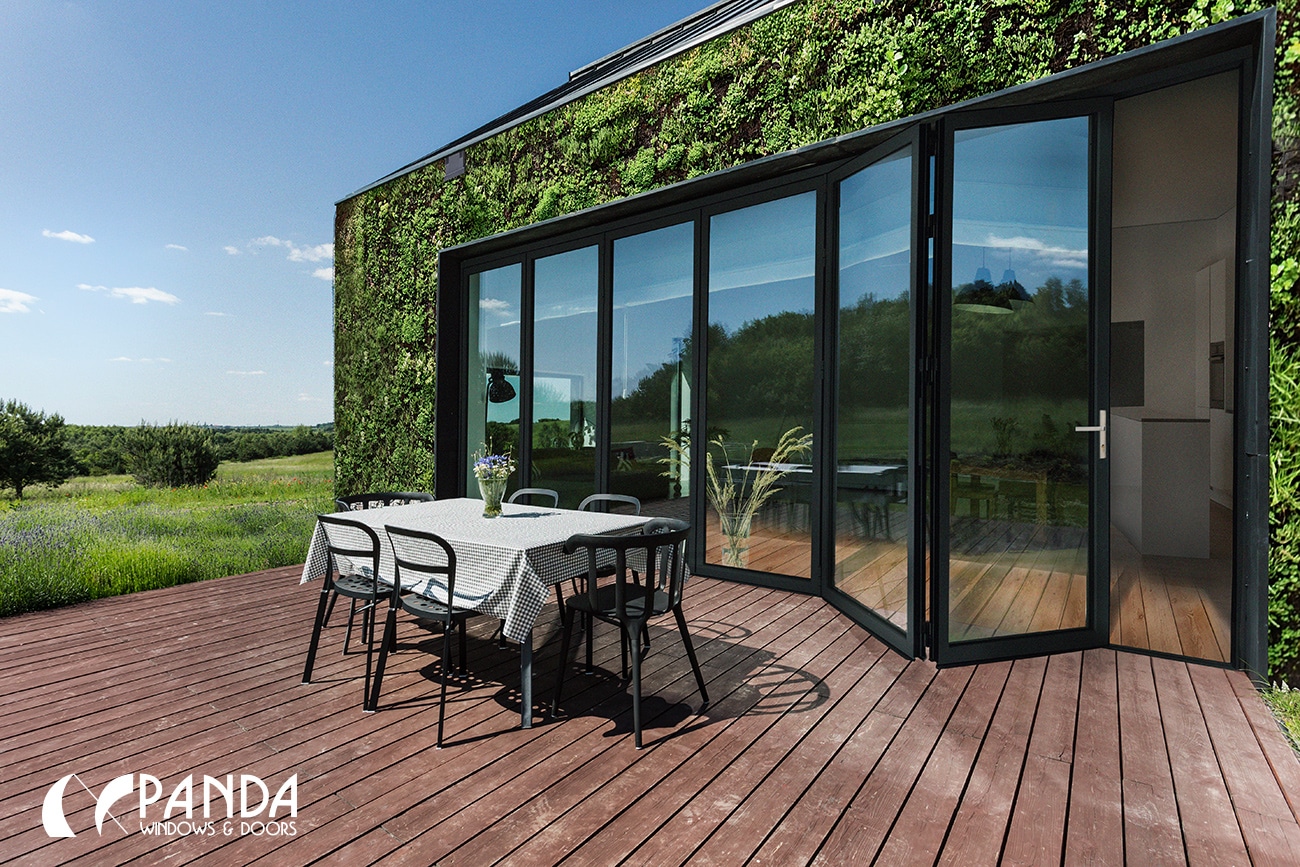
A Need to be Green
During the 1970s, U.S. oil production had dwindled significantly, resulting in the outsourcing of the fossil fuel from an Arab nation. But when tensions rose in the Middle East, and the U.S. intervened, an embargo was placed on the exportation of oil to the U.S by the Organization of Arab Petroleum Exporting Countries. This resulted in a shortage of gas and a dramatic spike in the price of it, causing governmental forces to encourage greener solutions. The U.S. was on a mission to minimize its dependency on this substance that acted almost as the lifeblood of modern society. The first Earth Day was celebrated in 1970, but the oil embargo marks the real start of the green build effort. In this search for more renewable energy sources, the first modern green building was created shortly after.
The Federal Environmental Executive defines a green building as “the practice of: 1) increasing the efficiency with which buildings and their sites use energy, water, and materials, and 2) reducing building impacts of human health and the environment through better siting, design, construction, operation maintenance, and removal throughout the complete life cycle.”
This effort was at its height in the 1970s, being championed by a group at the American Institute of Architects who formed factions to work towards developing greener architecture. Some green builds of note are The Willis Faber and Dumas Headquarters in England and the Gregory Bateson Building in California. The buildings utilized natural light to reduce the need for electric light fixtures, and utilizing windows made of higher quality materials to regulate climate coming from outside, and aiding in creating more energy efficient spaces.
Throughout the 70s and 80s and well into the 90s, research on energy efficient practices was making steady progress forward, leading to the further development of solar power technology, prefab construction materials and modular homes, water reclamation systems and the use of direct sunlight instead of energy consuming lights.
Greening of the White House
While in office, Bill Clinton ushered in the Green of the White House program to improve how energy efficient the White House operations were being handled. These efforts included shifting the types of lighting systems use—utilizing more natural lighting—shifting to energy efficient office equipment, instilling better recycling systems, using vehicles with cleaner fuel, and decreasing the amount of water and pesticides used in the White House’s landscaping. With all of these efforts, it was reported in March 1996 that the White House saved more than $150,000 in water, landscaping and solid waste expenditures. Since that shift in culture at the monument, the White House has saved roughly $300,000 yearly through further developed energy efficient practices.
Greenhouses
Another way people have been bringing a bit of green into urban landscapes is with green houses. Greenhouses serve as a protective structure for whatever you’re growing from the outside elements. Because some plants thrive in warmer environments while others cooler moist places, a greenhouse gives you climate control in a small environment regardless of where you live. They also allow the growing season to be extended year-round and what type of greenhouse you need is affected by the environment surrounding it.
But even more than control, greenhouses are used to bring a pocket of biophilic life to the most industrialized landscapes. Some famous greenhouses include:
- Eden Project in Cornwall, UK
- This structure is formed of multiple greenhouses and was built inside of a reclaimed China clay pit in the early 2000s. Each greenhouse mimics the environment of a different family of plants meaning they can foster plant species from all around the world.
- Palmenhaus Schönbrunn in Vienna
- This divine structure was the former summer residence of the Habsburg rulers and was completed as a greenhouse between 1891 and 1892. The garden structure houses an Olive Tree donated by Spain in 1974 and is said to be three and a half centuries old.
- Lincoln Park Conservatory in Chicago
- This Victorian era designed structure was built on top of an already established structure. It now includes four large rooms containing exotic plants and has an outdoor garden that one of Chicago’s oldest public gardens.
- Conservatory of Flowers in San Francisco
- This building, residing in Golden Gate Park was completed in 1879 and is one of the oldest buildings in the park today. It is also one of the first conservatories built in the US and is the oldest wooden conservatory in the US. This designated landmark is listed in the National Register of Historic Places and went through a $25 million renovation in the late 20th century.
Singapore in the Lead
Since declaring independence a little over 50 years ago, Singapore has become a hub of innovative infrastructural design and one of the leading countries in energy efficiency and sustainability. While most of this burgeoning metropolitan landscape was constructed over the course of the last decade, it is archeologically more advanced than many of the nations we’ve come to look to as some of the world’s most prominent cities. The designs combine glass, steel and natural materials to create a fantastical modern landscape that is not only aesthetically awe-inspiring, but also works to benefit the natural landscape that surrounds the utopia.
One of the key factors of success for this Garden-City’s Biophilic Design and sustainability efforts is government support. Architect Mayank Kaushal states, “Singapore is the only country that makes it mandatory by legislation for any building of about 5,000 square meters to achieve minimum standards as per the code for environmental sustainability.” This legislation comes in the form of several coalitions and acts for the nation’s development. The Singapore National Research Foundation created a program to promote sustainable future cities through research, science and design. This is only one of the huge steps Singapore has taken to ensure we won’t be trying to salvage a world that no longer exists in the near future. Additional efforts look like the Skyrise Greenery Incentives 2.0. With this scheme in place up to 50 percent of instillation costs of rooftops and vertical greenery would be subsidized with the act. It has already aided more than 100 projects to date.
Singapore’s Natural Landscape Buildings
Singapore architects have made the most of the industrialized landscape that has become this island nation. With bustling streets and closely placed buildings, there isn’t much room left on the ground for nature and organic life. So where do they go? Well, up of course. Rooftop gardens and vertical foliage is a prominent design feature of many of Singapore’s newest edifices. Here are a few and their key design features:
- The Oasia Hotel Downtown was completed in 2016. This 27-floor structure is wrapped in natural vine covered sunscreens. This feature offers functionality, energy efficiency (by blocking out the sun’s harmful rays) and a biophilic design element giving the building a futuristic utopian quality. It also includes four sky terraces, nearly 2,000 large planter boxes and four large structural cores for ventilation, lowering the energy cost of the hotel. This extravagant business houses over 33 species of plants and 21 species of creepers.
- Gardens by the Bay, designed by Wilkinson Eyre, completed in October 2016, is the largest climate-controlled greenhouse in the world. It is designed to contain 250 square feet of garden and houses more than 1.5 million plants. This complex comprised of two separate structures—the Flower Dome and The Cloud Forest Dome—work differently than most greenhouses. While most are crafted to have a warmer temperature for the plants, the Gardens by the Bay actually serve the purpose of cooling the interior due to the warm Singapore climate. This is achieved with a forest of 18 SuperTrees with built in cooling channels to control the climate of the surrounding flora.
- ParkRoyal on Pickering is a fantastical structure designed to be a hotel-in-a-garden concept meant to be the quintessential image of the garden-city that is Singapore. Completed in 2013 this four-story tall hotel contains rain sensors, solar power, and water conservation and light saving measures. This building was developed with a greater sense of material efficiency by using less concrete in construction. It features 161,459 square feet of sky gardens, waterfalls and planter walls, establishing greenery as more than twice of the space taken up on the building.
Singapore Green Plan 2030
Singapore action plans to develop sustainable efforts have dated back to 1992 when their first Green Plan was launched. Then, in 2002 the Singapore Green Plan 2012 was created. Several other smaller action plans were launched throughout the early 2000s and 2010s. Currently work is being done to implement the Singapore Green Plan 2030. The plan was released on February 10, 2021 with a goal to expand its sustainable efforts and cause a significant environmental impact by 2030. The plan is to build an even more sustainable and greener city with an emphasis on nature, renewable energy, limiting solid waste and strengthening food security by putting more efforts into farm work.
The plan will set aside 50% more land for nature parks, making it possible for every household to live within a 10-minute walk of a park. They will also plant one million more trees across the island, to absorb another 78,000 tons of CO2. Efforts also include reduction the amount of waste to landfill per capita per day by 20% and reducing household water consumption to 130 liters per capita per day. These are achieved through practices like NEWater or NEWSand which utilizes incinerator ash in construction.
The overall effort is to create a harmonious lifestyle between humans and wildlife, fulfilling the Biophilia hypothesis while also improving the mental health and quality of life of their citizens.
Nature on the Brain
“There is mounting evidence, from dozens and dozens of researchers, that nature has benefits for both psychological human wellbeing…You can boost your mood just by walking in nature, even in urban nature. And the sense of connection you have with the natural world seems to contribute to happiness even when you’re not physically immersed in nature.”
-Lisa Nisbet, PhD, University of Toronto, Canada
Dr. Nisbet is researcher of connectedness to nature and its influence on cognitive health and behavior. Nature is said to improve cognitive functionality and performance through strong or routine connections to it. It can improve attention, lower stress levels, and promote an overall better mood. This leads to efforts in U.S. city infrastructure to implement more biophilic design elements like city parks and lavish street landscaping.
Parks Have a Purpose
Over the course of the nineteenth century, public parks have become a lot more prominent to improve mental health and wellbeing in otherwise industrialized communities. The first city park in the US, developed in 1963, is credited to the Boston Common. Since then the use of city parks and small playgrounds to break up city infrastructure with an inviting interactive space, has taken off.
Take for instance, quick development track home neighborhoods in places like Las Vegas, Arizona and Southern California. The goals of these communities are to build as many homes as possible, which means a standard template or stencil is used in fabricating these suburban communities. That’s a lot of the same type of house in similar colors. So, the offices of parks and recreation use small public parks or lots of greenery for dogs, as a way of breaking up these monotonous developments. Here people can host barbecues, picnics, birthday parties and other miscellaneous special events; while also giving younger kids and teens a place to gather and socialize, or workout. They’re little pockets of fresh air that help break up the mundane nature of these cookie cutter communities. These parks, whether it is fully realized or not do wonders for improving our singular and collective mental health.
Rise of the Plant Parents
In March 2020 when the world shutdown and everyone was made to quarantine at home, mental health took a serious decline. People would go days, sometimes weeks without setting foot outside of their homes and apartments for fear of being exposed to the virus. While the CDC reported during this time that suicide rates actually dropped, other reports show that depression and anxiety levels across the nation are what really skyrocketed. These reports, at first, seem to conflict with each other, but upon further reflection, one could connect them to the fact that more people were spending time at home surrounded by family, friends and neighbors. This could either increase their mental wellbeing or possibly make it harder for them to commit suicide due to being surrounded by people.
But what about those who live alone? How are they coping or maintaining their mental well-being? One solution has been biophilia. Multiple garden stores and plant nurseries report sales spiking during the pandemic. According to a family owned and operated business in Southern California, plant sales went from 10-20 plants a day to nearly 200 plants a day during the lockdown. Social media was flooded with the hashtags #PlantMom #PlantDad #PlantParent of users who found an online presence by showcasing their green thumbs. Soon tiny New York apartments essentially become lush green houses.
This rise in plant parenthood comes from that innate desire to be connected to nature that the Biophilia Hypothesis offers us. People wanted to mimic the outdoors in their humble abodes. And it wasn’t just about crafting a personal Garden of Eden for the sake of “the vibes”—this foliage gave these homebound individuals a purpose. It was a way of putting care and attention into something other than the devastation right outside your front door. It was a way of minimizing larger than life worry into worrying about something you can directly affect, influence and even have a conversation with. Whether or not this plant lived or died wasn’t up to happenstance; it was up to whether the owner gave it enough sunlight and water. In this way the plant was a representation of how we cared for ourselves while we are at the height of awareness when it comes to our own vulnerabilities and mortality.
Additionally, these green beauties acted as a life clock. Being stuck inside for over a year—some working from home, some working their way through the Netflix catalog—the days tend to bleed together. You stop being able to tell Sunday from Thursday from August, all the while your plants growth are reminding you that time is indeed going on and life is in face moving forward. A necessary physical metaphor at a moment in time where you can feel utterly helpless and stuck in a never-ending saga of desolation.
Design-wise, plants add a bit of life to any room. It’s the same way we leave a TV on in another room to give our environment a heartbeat. Plants were used as prominent design element as hanging wall objects, ceiling fixtures, and centerpieces. These organic elements can be pivotal in creating an ambiance you can thrive in creatively and mentally. Physiologically, they also offer benefits in the way of ventilation and air quality. Plants add more oxygen in the air though the process of photosynthesis. Unfortunately, some plants stop photosynthesizing at night and begin to respirate like humans, which cause them to take in oxygen and release CO2 into the air. However, some plants continue releasing oxygen throughout the night including orchids, succulents and epiphytic bromeliads.
Food Insecurity
In early civilizations, humans had diets comprised of grown crops including fruits, vegetables, nuts, and grains. All things which, by today’s standards would be considered a “healthy and balanced diet.” However, once cooking began to alter foods chemistry, and we started to eat for flavor and pleasure, rather than survival, healthy eating became a bit more complicated. Now we were jam packing sugars and salts into dishes in order to exploit their flavor profile; or maybe we were looking for diversity in the foods that we had access to. Now, let’s complicate that even more with capitalism and consumerism and question why we can buy a cheeseburger for $2 and a salad for $8. Or why we can buy an entire pizza for $5, but a container of cashews can cost up to $15. These are a few factors that contribute to food insecurity.
Food insecurity is the frailty of a person’s diet and inclination to “unhealthy foods” due to a lack of accessibility to safe, nutritious and culturally relevant foods. This can lead to diet-based diseases including diabetes, high cholesterol and hypertension, that seem to be attributed to genetic pre-dispositions to such ailments, but are actually a part of a much larger image of food insecurity. Food insecurity can lead to consumption of high energy foods, less fruits and vegetables and lack of food diversity. Eating a healthy and well-balanced diet is sometimes a privilege that not every family has the luxury of partaking in, because they must prioritize feeding many family members or making a meal stretch over the course of week.
While some turn to government assistance to aid with buying groceries and necessities for infants and small children, these programs don’t always help with food literacy, because you can have all of the money in the world for groceries, but unless you were taught to shop for and put together healthy meals and snacks, you will often turn to what you know and what is comfortable. Additionally, some, if able, turn to food literacy programs that aid in accessibility to nutritious food and skill building such as cooking and budgeting. But even still, food literacy can only help so much, because even with knowledge of how to eat properly, that cannot change the price of these nutritional foods, making them once again inaccessible. So, what other options are available to those looking for a more sustainable and natural way to reclaim their power in food and diet? One biophilic solution is gardening and growing food themselves.
Urban Gardening
A part of the innovation brought about by biophilia lies in urban agriculture and gardening. During the pandemic many people had extra time to pick up a new hobby, like gardening, and with the rise in interest in agriculture and plant care on social media, urban agriculture enthusiasts have garnered popularity for their commitment to feeding their neighborhoods and creating a more self-sustaining community. According to a recent survey on lawnstarter.com the top ranked U.S. cities for urban gardening are St. Louis, MO, Cincinnati, OH, Atlanta, GA, Macon, GA and Salt Lake City, UT. The survey took into account the available gardening spaces, the supplies, the climate, and the community. Urban gardens provide communities with a myriad of benefits including community building, diversified economies, civic engagement, climate resilience and self-sustainability.
These ecologically sound and socially just food alternatives allow community members to take back power in their food production and what they consume. They can become involved in their own food production through volunteering, community-based events hosting my urban farming entities or even through growing their own food. These gardens are a great way of bringing fresh fruits, vegetables, herbs and herb-based products into a community. Access to these fresh produce items has a positive effect on their consumption and promotes a well-rounded diet.
Urban farms are an innovative biophilic design solution to food sustainability because they are constructed to be placed and made to thrive in the middle of incredibly industrialized cityscapes. They are built in green houses, on roofs, in empty lots and even vertically up the sides of buildings. Some of the most innovative urban farms are:
Public Farm 1 in Queens New York
This urban farm is powered entirely by solar fixtures and has a chicken coop, juicing station, rainwater collection system, children’s play space, and even a cell phone charging area. The space hosts social events and frequent farmer’s markets.
Athenaeum Hotel in London
This gorgeous structure is a perfect blend of classic British architecture with modern design elements. It features a ten-story vertical garden that was installed in 2009. The structure is a visually awe-inspiring tower of biodiversity.
ACROS building in Fukuoka, Japan
Designed by Emilio Ambasz & Associates, this international center for cultural and information exchange opened its doors in 1995. It is located in downtown Fukuoka, Japan and grows 35,000 plants on 15 stepped terraces. The building is shaped to capture the rainwater runoff and support the lives of beneficial insects and birds. This is a 100,000 square-meter park in the center of a metropolitan city.
Community Supported Agriculture
Community Supported Agriculture, or CSA, is a community’s, “pledge support to a farm operation so that the farmland becomes, either legally or spiritually, the community’s farm, with the growers and consumers providing mutual support and sharing the risks and benefits of food production.”
In a CSA model, the community will usually buy a share of the farm’s production expenses at the beginning of each growing season and will, in return, receive regularly distributed goods throughout the season. This also allows the farmer to have financial security, get better crop prices and benefits from the direct marketing.
Different Ways of Doing
Urban gardening has taken the traditional way of planting and growing herbs, fruits and vegetables and crafted innovative techniques to get around locale climate factors when starting a garden. Two popular methods being used by urban gardeners are Aquaponics and Hydroponics:
- Aquaponics is a farming system that creates a cooperation between plants and fish in a recirculating ecosystem. The process uses fish to eat and produce waste and natural bacteria, then uses the nutrient rich water to grow the plants. For this method, specific types of fish are required because of the environment they must be in to produce so much waste. Tilapia is one of such fish because they can thrive in less-than ideal water conditions and handle more stress. They are also more resistant to pathogens and parasites.
- Hydroponics is the method of growing plants in a soilless environment. The plants are grown in a solution that links them to an irrigation system so that the plant may get al of its nutrients. This gardening method is perfect for utilizing smaller spaces and produces little to no weeds. This process also lets plants be grown year-round with artificial light.
Let Panda Provide the View
Established in 1991, Panda Windows and Doors specializes in glass fixtures built to maximize your space. Here, we value innovation design and engineering solutions, top quality performance and energy efficiency. All of this makes our modern line of products the perfect asset for all of your biophilic spaces.
We pride ourselves on our flexibility to engineer any door or window to fit the architecture of your commercial or residential space. With a group of in-house engineers and designers working to bring your vision to life, virtually any unique design can be tailored to your property’s aesthetic.
Panda offers more than 50 high quality systems of doors, windows and screens. Here are a few to help integrate an energy efficient biophilic design solution:
Horizontal Sliding Walls
One of the most sought-after elements of biophilic design is a gorgeous view. With Panda’s Horizontal sliding walls, you can remove the barrier between your home office, commercial property or living space, and the natural world just outside. These multi-configurable systems bring a modern edge to any room.
With a custom engineered parking area, this system has the ability to pocket around a corner and out of sight, creating a full clearing in your space. We also offer a frameless option to remove even more intrusions from the view of nature. Additionally, an operable swing panel can be applied to this design for a daily French-door style use, and with a concealed hardware system, these doors are a security asset to your property when fully closed and locked.
Our Horizontal Sliding Walls have a thermally broken aluminum option and a thermally broken aluminum/wood clad option, offering energy efficient design solutions to your building. These systems are perfect for large openings in properties that reside in extreme climate conditions. The thermally broken technology prevents the flow of thermal energy and provides protection against the elements. This means that cool air stays in during the warmer months and the warm air stays in during the chillier times of year, allowing for less dependency on air conditioning and heating systems. Our Horizontal Sliding Wall systems offer six different system types to fit your specific needs.
TS.X0 Multi-Slide
With an ultra slim profile, you can have a virtually unobstructed view of your panoramic landscape with the TS.X0 system. These enormous floor to ceiling glass panels can exceed 15 ft in height, transforming your space into an observatory that brings your menagerie of foliage right into your living space. Our structurally reinforced stiles are engineered to maintain mechanical integrity without sacrificing the beauty of these sleek and modern glass panels.
The TS.X0 Multi-Slide glass door system also has an option to be designed as curved glass radius system for those looking for a bolder design solution. This modern design element allows for more sunlight to enter your space and offer your plants the energy source they require to thrive in your indoor space.
Steel Windows and Doors
When design and technology meet glass and steel, you get the Panda X Tuval USA line of windows and doors. This timeless line of products is the perfect environmentally conscientious design solution. With steel being 100% recyclable and having a much longer lifespan than other building materials, this durable metal lasts for generations. A virtually maintenance free resource, steel produces less CO2 emissions than other construction supplies and minimizes construction waste.
Tuval Steel offers thermally broken and weather resistant products that aid with ventilation and climate control, allowing you to keep the cost of comfort low. And due to the strength of steel, this functionality doesn’t have to be cumbersome, because this material allows for thinner profiles that can still stand up to the most inclement weather.
Windows
After choosing from one of our three operable window systems—All Aluminum S.45, All Aluminum Thermally Broken TS.67 or Aluminum/Wood Clad S.46—You will have a selection from nearly endless customization options when it comes to your window system. Our windows offer several operating configurations including Awning, Hopper, Casement, Tilt & Turn and Fixed. And if you’re looking for an even more awe-inspiring window design solution? Our windows can also be configured as a radius system. From there, you have an option from a wide array of finishes including powder coated finishes, wood and faux wood. And if none of our pre-made finish options fit your pre-established design aesthetics, custom finishes are available upon request.
Screens
Being outside doesn’t have to mean shutting out the elements with Panda’s retractable screens. Our accordion-style pleated design can be applied to just about any window or door system and can accommodate openings up to 16’ wide and 10’6” high. These systems come in a variety of colors and custom design options and are easy to install with simple snap on and snap off technology.
With two design configurations—the cascade screen and fixed screen—these two fixtures can craft an atmosphere reminiscent of a relaxed beach getaway or a sleek and modern beach home. Either way, you’ll be enjoying a touch of the elements in every room of your home.
Questions about Biophilic Design
- What is biophilic design concept?
- Biophilic design is a way of purposefully integrating and/or invoking nature into the architectural design of a space.
- What is biophilic design examples?
- Some examples are indoor plants, running water features or ponds indoors, large glass windows to allow a view of the nature outside, or even organically shaped furniture inspired by natural shapes and objects.
- What is the purpose of biophilic design?
- Biophilic design is said to have a great effect on mental health and well-being. Humans are said to have an innate connection to nature, and Biophilic design combats the industrialized world we’ve come to live and dwell in.
- How do you make biophilic designs?
- A biophilic design/ inspired home can be created in a number of ways, including one of Panda’s glass wall systems. These sliding doors allow for a nearly unobstructed view the nature right outside your door.
- What is the moral of sliding doors?
- Panda’s sliding doors are a compact and modern way of opening up your space. And with several of our Panda Select thermally broken sliding doors, your residential or commercial property is sure to be more energy efficient.
- What are the types of Sliding Doors?
- Panda offers a variety of sliding doors including:
- X0 thermally broken aluminum system for a virtually unobstructed view to the world beyond
- 83 All aluminum thermally broken slim profile multi slide for a lightweight energy efficient addition to your home
- For a more budget friendly option, look to our Panda Select line of sliding doors like the Lift and Slide 30, LTS.31, LS.30 or the all-aluminum S.30 multi slide system
- Are sliding doors a good idea?
- We might be a bit biased, but we believe Sliding Doors a staple of modern society and is sure to open up your biophilic space and let in plenty of sunlight for your plants.
- Panda offers a variety of sliding doors including:
Download one of Panda’s door buying guides to help determine the perfect door that’s right for you. Our selection is expansive, and you’re sure to find the perfect door for your style, space, and life.

Door & Window with Double-Glazed Glass | Pros, Cons & Cost
Learn the benefits, drawbacks, and costs of double-glazed glass doors and windows in this detailed guide.

Folding Door vs French Door: Which Is Better?
Compare folding doors and French doors to determine which is better for your home, focusing on design, functionality, and style.
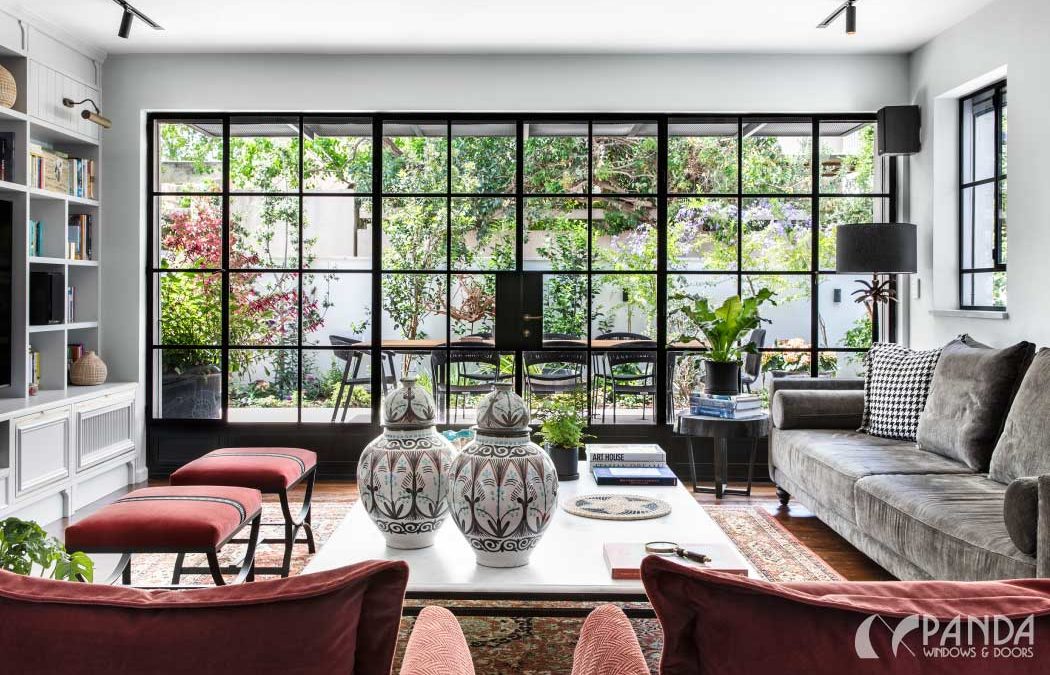
Custom Stainless Steel Doors & Windows | Cost, Pros & Cons
Explore custom stainless steel doors and windows, including their costs, pros, and cons, to determine if they’re right for your project.





